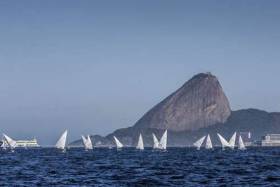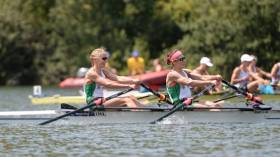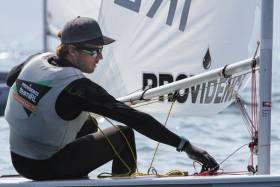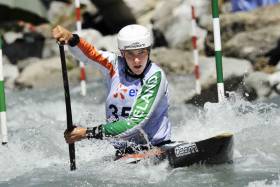Displaying items by tag: Olympics
With less than 75 days to go until the opening of the Rio 2016 Olympic Games, World Sailing Chief Executive Officer Andy Hunt and Head of Competitions Alastair Fox this week participated in a final on-site review of preparations for the Olympic Sailing Competition.
Briefings were provided over two days on key operational and service areas for the Olympic Games, including venue construction, competition schedules, broadcasting, media operations, accommodation, transportation and ticketing. A detailed briefing was also provided on the continuing efforts to improve water quality in and around Guanabara Bay, the venue for Olympic Sailing.
The briefings were led by Rio 2016 Sport Sailing Manager, Walter Boddener, and his operations team. Hunt and Fox were joined by Darryl Seibel, who will serve as Chief Press Officer for World Sailing during the Rio 2016 Olympic Games.
The World Sailing delegation also met with Rio 2016 security officials to learn more about steps that can be taken to increase safety for athletes and coaches, particularly during pre-Games training periods. This advice will be shared directly with World Sailing Member National Authorities, according to Hunt.
"We appreciate the work being done by Rio 2016 and its partners to welcome the best sailors from around the world for the 2016 Olympic Games,” said Hunt. "Since our last visit in March, considerable progress has been made in preparing for the Olympic Sailing Competition. Construction at the Marina da Gloria is almost complete and the water quality is noticeably better, particularly in the launch areas around the marina.
"During our review, we had an opportunity to meet with officials from the Mayor's Office and leading environmental authorities to review their latest water-quality data,” added Hunt. "The trend lines are encouraging, but it will be important that not a single day is lost in implementing the remaining measures that are planned, including the installation of a series of new eco barriers.”
"Our primary focus is to make certain the field of play on Guanabara Bay is safe and suitable for all Olympic competitors,” said Fox. "Working with Rio 2016 and various governmental authorities, I'm confident we have the right plan in place to deliver a field of play that is safe and fair. Equally, as with every major sailing regatta, we have detailed plans in place to respond and adapt should conditions change.”
The natural beauty of Rio de Janeiro will provide a spectacular backdrop for sailing, which will enjoy a particularly bright spotlight during the upcoming Olympic Games.
"Brazil has enjoyed tremendous success in Olympic sailing and athletes such as Robert Scheidt, Torben Grael and Marcelo Ferreira hold a special place in Brazil's sporting culture,” said Hunt. "Given this history of success and the profile sailing enjoys in Brazil, it is our hope that the beaches surrounding Guanabara Bay will become one of the truly special places for fans during the Rio Games.”
Rowers In Team Ireland's First Selections For Rio 2016
#Rio2016 - Four rowers have been included in Team Ireland's first formal selections for this summer's Olympic Games in Rio.
Sinead Lynch and Claire Lambe in the lightweight women's double scull and the team of Paul and Gary O'Donovan in the lightweight men's double scull were put forward by Rowing Ireland in the first group of selected athletes for Rio 2016 announced on Friday 20 May.
"The athletes selected have fantastic potential and have shown that they are capable of performing against the very best in the world," said Kevin Kilty, Team Ireland's chef de mission for Rio 2016.
"We will provide them with the best possible high performance environment in Rio in order that they can perform at their best.”
The four rowers join two badminton hopefuls, two gymnasts and a six-strong boxing contingent – including Olympic medallist Paddy Barnes – in the first team announcement.
#Rio2016 - Rio's water 'will be ready' for sailors when the Olympic Games begin in August, according to China's Xinhua News Agency.
Speaking at an event to mark the lighting of the Olympic torch in Athens on Thursday (21 April), International Olympic Committee president (IOC) Thomas Bach told the media: "We are very confident that the competition area for the athletes will offer safe and fair conditions.
"The city, the state and the organising committee are undertaking many efforts and what we see now is that 60% of the surface is clean," he added. "Without the Games it would be zero."
However, Bach made no reference to concerns over viral contamination of the notoriously polluted Guanabara Bay, nor the risk posed to female sailors by the spread of the Zika virus.
Espey Backs 'Flow' Campaign For Watersports In Northern Ireland
#JamesEspey - Olympic Laser hopeful James Espey made time in his busy Rio 2016 training schedule for to help launch a new campaiign aimed at getting people involved in watersports, according to the News Letter.
As previously reported on Afloat.ie, the Flow campaign is a partnership between SportNI and various sporting bodies that's encouraging water-based activities in the run up to September's European Week of Sport.
Watersports clubs around Northern Ireland will be offering taster events on the weekend of 14-15 May to get things running, and Espey is fully behind the initiative.
"This new Flow campaign is absolutely ideal for those with no background in watersports whatsoever," said the Olympian who still trains where he first learned to sail at Ballyholme.
“It will be a fantastic introduction for anyone wanting to get into water based activities across Northern Ireland.”
The News Letter has more on the story HERE.
Ireland International Places on the Line at Lucan
#Canoeing: The top Irish competitors in canoe slalom will be in action at the Irish Championships at the Sluice Weir in Lucan this Saturday and Sunday, March 5th and 6th. The races at the redeveloped Sluice Weir in the Lucan Demesne/St Catherine’s Park, will double as selection races for the Ireland senior and junior international teams for:
- The Senior European Championships in Liptovsky Mikulas, (Slovakia) in May.
- The five-event World Cup series in Ivrea (Italy), La Seu d’Urgell (Spain) and Pau (France) in June and in Prague (Czech Republic) and Tacen (Slovenia) in August.
- Junior and Under 23 World Championships in Krakow (Poland) in July and European Championships in Solkan (Slovenia) at the end of August.
The Senior European Championships in Liptovsky Mikulas will also count as the final qualification event for places at the Olympic Games. Only one place is available in each class to European countries who have not yet qualified.
Racing on both days will feature London 2012 K1 finalist Hannah Craig, who is entering her second season back to competition following the birth of her son Arlo in May 2014. Hannah has spent the winter at the artificial whitewater course in Nottingham, England in preparation for the 2016 season.
Competing in the C1 category will be Liam Jegou who took 6th place in the Under 23 European Championships in Krakow last year and got semi-final placings in two of his three World Cup races and in the World Championships in his first season of senior races. He has just completed a winter-training bloc on the artificial whitewater course in Al Ain, Dubai.
Robert Hendrick will double-up with his brother Noel in the Under 23 C2 class over the weekend, having taken 4th place in the Junior World Championships in Brazil last year.
In the K1M class, Ciarán Heurteau is coming back to Ireland from a two-month intensive winter training bloc in New Zealand to compete for a place at the European Champs and Olympic qualifier after being out of competition last season due to an anterior cruciate ligament injury which required surgery and rehabilitation.
To provide a good benchmark to assess selection performance levels, Canoe Slalom Ireland are bringing in Mike Kurt (30th in men’s kayak world rankings and semi-finalist in the 2015 World Championships) from Switzerland. The Welsh junior and under-23 team will also take part.
Annalise Murphy Candid About Expectations For Rio 2016
#AnnaliseMurphy - Annalise Murphy is clear about what she needs to do to have a shot at the Olympic podium in Rio this summer – sail better in lighter winds.
As the championship-calibre Laser Radial specialist tells The42 in a revealing interview, expectations of a guaranteed medal on Guanabara Bay after she narrowly missed out on bronze in London 2012 are unwarranted.
"To be honest, I haven’t been sailing as well as I could have over the past year and a half,” she tells The42's Paul Fennessy. “I think my training’s been going really well and my preparation’s been good. My racing hasn’t been at the standard that I’d like it to be at."
And the big weakness in Murphy's game is one long known to Afloat.ie's readers: her lacklustre performance in lighter winds.
While continuing to show strong form in challenging gusts, such as at Palma last March, the former European champion failed to defend her title in Croatia the year before due to the light and shifty breezes.
But the 26-year-old is candid about the need to "improve [her] confidence in the surfing conditions".
Indeed, that appears to be a much bigger priority for the Rathfarnham native and National Yacht Club stalwart than any concerns about pollution in the Olympic sailing venue – from floating debris to the risk of viral infection, not least the threat of the recent Zika outbreak.
The42 has much more on the story HERE.
Rio 2016: Zika Poses Risk To Female Sailors
#Rio2016 - Female athletes with places in this summer's Olympics have been left with a tough decision to make due to the outbreak of the Zika virus in Rio and elsewhere in Brazil.
And as Sail-World reports, sailors particularly at risk – as the waters of Guanabara Bay make the perfect breeding grounds for mosquitoes that carry the virus implicated in causing severe birth defects.
The Australian Olympic Committee has already advised its female competitors to consider the risks involved as the Zika situation continues to evolve – and it's expected others will follow in their wake as a number of South and Central American countries are recommending a two-year moratorium on pregnancies.
Coming in the same week as the Notice of Race being issued, it's just the latest health and safety setback to hit the Rio 2016 games after long-time concerns over pollution in the sailing and rowing venues in Brazil's largest city.
Sail-World has more on the story HERE.
Rio Is The Goal For Salmon Leap Paddler Jenny Egan
#Canoeing - Coming off a strong 2015, where she claimed the bronze medal at the World Championships in the Czech Republic last summer, Lucan's Jenny Egan took time to answer a few questions from The Irish Times before her pre-Olympic training kicks up a gear.
Indeed, if not for a short illness laying her low for a few days over Christmas, Egan's dedication would already be off the charts – with as many as 16 sessions of land-based hard winter training every week.
But it's worth it for the Rio 2016 hopeful, who says she was "on cloud nine" for most of 2015 with her bronze medal followed by almost reaching the podium again in Baku in June, a sixth-place finish in the K1 5,000m in Milan and a fourth-place finish in the Canoe Marathon Worlds in Hungary.
And that's not to mention a win in September's Liffey Descent with her boyfriend Jonathan Simmons in the mixed K2.
The Irish Times has much more on the story HERE.
Rio Locals Point To Pollution Over Olympic Sailing Venue Fish Kill
#Rio2016 - 'Tropical heat' has been blamed by Rio government officials for the thousands of dead fish that washed up this week on the shores of Guanabara Bay, venue for this summer's Olympic sailing events.
But as Scuttlebutt Sailing News reports, locals are not so sure – believing contamination of the bay's notoriously polluted waters to be the real cause.
Just last month it emerged that sailors who ingest just three teaspoons of water from the planned Olympic sailing courses have a 99% chance of contracting a viral infection.
City authorities, meanwhile, also investigating whether the fish – mostly sardines – may have been illegally discarded by commercial fishermen.
It comes nine months after a similar fish kill clogged the Olympic rowing venue at the Rodrigo de Freitas Lagoon – a common occurrence in a body of water that periodically suffers from shortage of oxygen.
#Rio2016 - Sailors in Rio who ingest just three teaspoons of water from the Olympic courses on Guanabara Bay have a 99% chance of being infected by a virus.
That's according to the latest damning findings from the Associated Press, following from its own investigation earlier this year that found levels of viruses detected at the Olympic sailing venue to be as much as 1.7 million times this allowed on California beaches.
Samples taken more recently now indicate that a high concentration of viruses is detectable even more than a kilometre offshore away from the pollution sources that have plagued Rio's waters for decades.
Despite assurances by the ISAF – which previously floated the idea of moving the sailing venue out of Rio to cleaner waters – that steps were being taken "to ensure the health and safety of all athletes", there was still an illness rate of 7% among sailors competing at an Olympic test event in August.
That figure included 49er bronze medallist Erik Heil, who was treated for severe inflammations in his legs and a hip.
The cause of his illness turned out to be the superbug MRSA, and Heil has since proposed wearing plastic overalls while sailing out from the shore to limit his exposure to that an other bacterial infections.
But experts in waterborne viruses have told the AP that such efforts are futile when Rio's Olympic waterways "are as rife with pathogens far offshore as they are nearer land".
The AP has much more on the story HERE, coming in the same week as the ISAF's chief executive Peter Sowrey resigned after only six months in the job – the latest in a spate of high-profile departures from sailing's world governing body.

































































